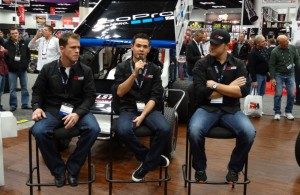Motorsports News: Now And Then
- Updated: April 11, 2011
We don’t realize how lucky we are.
Recently I had the opportunity to purchase some vintage copies of one of motorsports iconic publications; Speed Age magazine. These issues were from 1947 and 1948, the first years that it appeared on the nation’s post-war newsstands. Reading these monthly issues helps us realize how far we’ve come in our media coverage of auto racing.
Heading the inaugural issue of Speed Age was an article by Wilbur Shaw, previewing the forthcoming Indianapolis 500. Today you would never find an article written by the track’s president, promoting his own race. Included in the issue was another story touting the “All-American Soap Box Derby” as the “greatest amateur racing event in the world”. Race fans were starved for anything on four wheels after WWII, and the Akron, OH, event regularly drew crowds of 100,000-plus to its “gravity grind.”
The language used by the publication’s writers seems a bit archaic by today’s standards as “railbirds” watched the races; and, regarding the Indy 500: “The speed will be in the cars. The weight will be in the foot of the drivers- the prizes will be beckoning to all-out effort. The skill will be in the pilots to guide the fast-flying new and hopped-up older models to greater performance.”
Monthly issues of Speed Age, along with the weekly arrival of National Speed Sport News, were often the only contact that racing fans had to find out who won races on the AAA circuit or even at their favorite local track. Daily newspapers rarely had racing writers; Indy was on the radio in primitive form; and TV was in its infancy with little or no regular coverage of motorsports events.
Schedules of up-coming events, combined with press releases issued by sanctioning bodies filled the first issue’s modest 32-page effort. But for its time it was a first, tentative step toward bringing you the explosion of coverage in so many forms that racing enjoys today.
Who ever thought that one could watch live coverage of every round of the Formula One World’s Championship; or be in the car with NASCAR and Indy Car’s best drivers as they race with you feeling like you’re there looking over their shoulder? Or how about live streaming of events on your computer, checking in on practice and qualifying while you’re still at work? Every track today seems to have a web-site to keep fans abreast of point standings, race results and next week’s ticket promotions.
Imagine trying to explain all of this to 1947’s race fan.
We often complain when the network we’re watching misses an important pass during the race, or the announcer fails to note what happened to our favorite driver who’s been in the pits for ten laps. Radio, TV, internet and media coverage is often taken too much for granted today to be appreciated.
Speed Age bit the dust by 1960, and NSSN was one of the last of its breed of weekly racing trade papers to survive from the 1930’s until just last March. It became a victim of information coming to readers too slowly in an age where most know results before they go to bed on Sunday night and have already seen numerous replays of the weekend’s highlights.
Speed Age grew and got more professional in its coverage in later years under the guidance of its Editor, Don O’Reilly. It formed a solid bridge from the time when there was basically no racing coverage, to today’s sometimes voluminous reporting.
But to help us appreciate the events of today, we do need to look back at what happened in the past, and collecting issues of Speed Age allows me to do just that. A case in point: The February1948 issue noted a meeting that took place in a small resort town on Florida’s Atlantic Coast. Speed Age reported the following: “What may turn out to be the most advanced step in a decade for the betterment of the auto racing sport has just been completed at Daytona Beach, Florida.
“It is the formation of the new, and all-encompassing National Association of Stock Car Auto Racing. The purposes of this association are to unite all stock car and roadster racing under one set of rules; to set up a national benevolent fund and a national point standing system whereby only one stock car driver and one roadster driver will be crowned as National Champion each year ” And you read it first in Speed Age magazine.
Paul Gohde heard the sound of race cars early in his life.
Growing up in suburban Milwaukee, just north of Wisconsin State Fair Park in the 1950’s, Paul had no idea what “that noise” was all about that he heard several times a year. Finally, through prodding by friends of his parents, he was taken to several Thursday night modified stock car races on the old quarter-mile dirt track that was in the infield of the one-mile oval -and he was hooked.
The first Milwaukee Mile event that he attended was the 1959 Rex Mays Classic won by Johnny Thomson in the pink Racing Associates lay-down Offy built by the legendary Lujie Lesovsky. After the 100-miler Gohde got the winner’s autograph in the pits, something he couldn’t do when he saw Hank Aaron hit a home run at County Stadium, and, again, he was hooked.
Paul began attending the Indianapolis 500 in 1961, and saw A. J. Foyt’s first Indy win. He began covering races in 1965 for Racing Wheels newspaper in Vancouver, WA as a reporter/photographer and his first credentialed race was Jim Clark’s historic Indy win.Paul has also done reporting, columns and photography for Midwest Racing News since the mid-sixties, with the 1967 Hoosier 100 being his first big race to report for them.
He is a retired middle-grade teacher, an avid collector of vintage racing memorabilia, and a tour guide at Miller Park. Paul loves to explore abandoned race tracks both here and in Europe, with the Brooklands track in Weybridge England being his favorite. Married to Paula, they have three adult children and two cats.
Paul loves the diversity of all types of racing, “a factor that got me hooked in the first place.”





![Porsche Fabcar crosses the finish line. [Robert Madara photo]](https://racingnation.com/wp-content/uploads/2023/11/FabcarFinish-108x70.jpeg)

![USF2000 Pro driver Lindsay Brewer. [Eddie LePine Photo]](https://racingnation.com/wp-content/uploads/2023/06/IMG_8825_2-108x70.jpg)